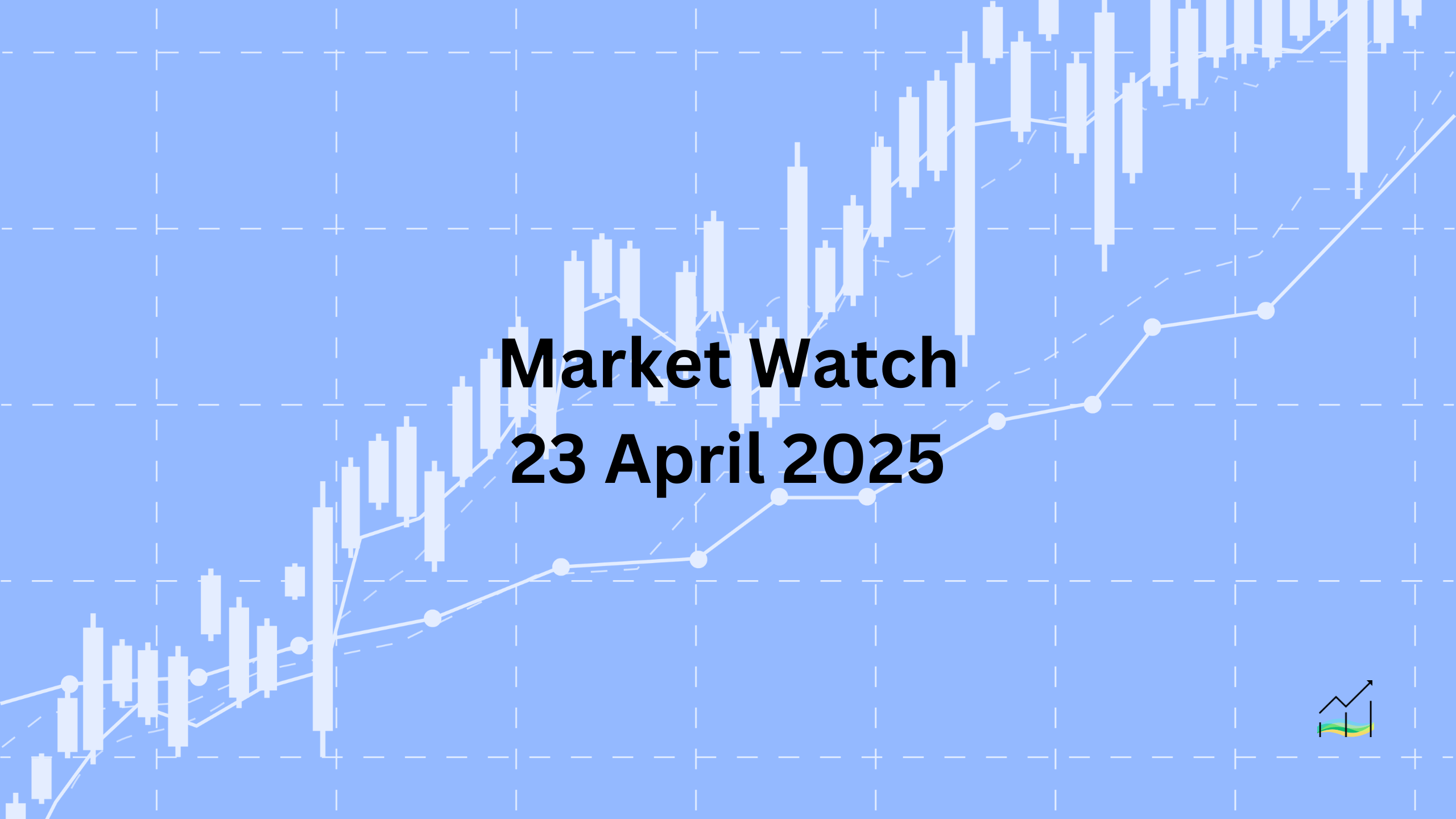23/04/2025 Market Watch

Trade Tensions Ease, Growth Risks Remain
Key Takeaways:
- Trump says he has no intention to fire Powell, easing Fed independence concerns.
- US-China trade rhetoric softened; a deal is said to be possible, though no confirmation yet.
- IMF slashes global growth forecast to 2.8%, with China downgraded to 4.0%.
- Equities and USD rallied on improved sentiment, but gains may prove short-lived.
Asian equities and S&P 500 futures pushed higher overnight after President Trump backed away from threats to fire Federal Reserve Chair Jerome Powell. The move eased immediate concerns over the independence of US monetary policy, just one day after reports suggested the White House was exploring legal avenues to remove Powell. The dollar and broader risk assets gained on the shift in tone, though many view this as a temporary relief rather than a meaningful turning point.
Markets also reacted positively to a softening in US trade rhetoric. Trump stated that tariffs on China are likely to come down “substantially,” while Treasury Secretary Bessent described the current trade relationship as unsustainable and suggested a deal was within reach. Reports emerged of a potential Trump-Xi meeting in early May, though there has been no official confirmation. Meanwhile, the White House is reportedly close to securing memorandums of understanding with Japan—smaller-scale trade arrangements that fall short of formal agreements.
However, these gains come against the backdrop of a deteriorating global economic outlook. The IMF slashed its 2025 global growth forecast to 2.8%, down from 3.3% in January, with next year revised to 3.0%. Forecasts for China were cut by 0.6% to 4.0% this year, and 0.5% to 4.0% next year. The IMF warned that if recent tariffs are assumed permanent, the growth hit to both China and the US will deepen into 2026 and beyond. Short-term optimism is running up against long-term structural risk.
United States of America
Overview
The dollar staged a recovery alongside US equities as concerns over tariffs eased and positioning flows helped rebalance markets. While recent attacks on Fed independence raised legitimate downside risks for the dollar, its oversold condition and undervaluation left room for a technical rebound. Treasury Secretary Bessent’s remarks that the current tariff situation with China is “unsustainable” and likely to de-escalate gave markets a temporary lift, though sentiment remains fragile.
The greenback’s sensitivity to trade headlines is now unmatched among G10 currencies. While the near-term balance of risks still tilts bearish, the phase of one-sided dollar selling appears to have peaked. A period of stabilisation—not renewed structural weakening—seems more likely heading into May. Today’s S&P Global PMIs may add short-term volatility, but they are generally overshadowed by ISM surveys when it comes to FX relevance.
Economic Drivers
- Bessent signals near-term trade de-escalation, easing tariff-related stress.
- Dollar oversold conditions prompted rebound amid better FX liquidity.
- Fed independence concerns continue to weigh on sentiment.
- USD remains highly reactive to trade headlines; short-term volatility elevated.
Data and Events
- April 23 – S&P Global Preliminary PMIs (April)
- April 24 – Fed Beige Book
- April 25 – Weekly Jobless Claims (week of April 20)
- April 26 – March Durable Goods Orders
- April 30 – Q1 GDP (Advance Estimate)
Price Action
- DXY rebounded but remains technically vulnerable.
- Near-term support levels still under pressure if sentiment shifts again.
- USD upside capped unless Fed credibility concerns ease materially.
- Structural dollar bias now leans toward stabilisation, not renewed strength.
Key Points:
- Dollar recovered on trade optimism and technical rebalancing.
- Fed independence concerns cap upside, but oversold conditions limit downside.
- FX markets increasingly headline-driven—especially by trade and central bank rhetoric.
- USD weakness remains a theme, but not in a straight line.
Europe
Overview
When the dollar gains on improved US risk sentiment, it often triggers sharp unwinding in the currencies that have taken on safe-haven roles—chiefly the euro, Swiss franc, and yen. In the current FX environment, the specific reason behind dollar strength appears less important than the reaction it provokes. The euro, in theory, should benefit from de-escalation signals in the US-China trade relationship, but positioning dominates for now. Alongside JPY and CHF, the euro is particularly vulnerable to USD rebounds, showing an asymmetric sensitivity relative to other G10 currencies.
Eurozone PMIs due today are expected to show a moderate decline, despite recent tariff developments. The surveys were conducted after the 90-day trade pause announcement, supporting the relatively stable consensus outlook. Importantly, the ECB is treating tariffs primarily as a downside risk to growth rather than a threat to inflation. A soft PMI reading—especially a dip below the 50.0 threshold—would further validate the market’s dovish expectations, which currently price in 75 basis points of additional rate cuts by year-end.
Still, EUR/USD remains largely a function of broader USD moves. A renewed focus on Fed independence risks could easily push the pair back above 1.15, with upside coming from dollar weakness rather than euro strength.
Economic Drivers
- EUR behaves like a safe-haven proxy; vulnerable to USD-driven position reversals.
- Market positioning outweighs eurozone fundamentals in near-term price action.
- ECB is more focused on growth risks than inflationary pressures.
- PMI weakness would reinforce expectations for additional ECB easing.
Data and Events
- April 23 – S&P Global Preliminary PMIs (April)
Price Action
- EUR/USD pullback reflects USD positioning more than eurozone data shifts.
- Support remains firm above 1.12; upside to 1.15–1.16 remains plausible.
- Key technical risk remains Fed-related headlines driving USD volatility.
Key Points:
- EUR reacts to USD strength more than its own fundamentals.
- Soft PMI could weigh on sentiment but is unlikely to break the broader trend.
- Another move above 1.15 depends entirely on the US policy narrative.
Japan
Overview
USD/JPY began the day under pressure as concerns about the US economic outlook intensified, reinforcing safe-haven demand for the yen. However, as the pair approached the September 2024 low of 139.89, the market staged a rebound, suggesting limited appetite to push the exchange rate below this key technical level—at least for now.
Recent inflation data from Japan has reduced pressure on the Bank of Japan to act. The latest core CPI reading came in at 2.2%, lower than expected, easing the case for further near-term tightening. At the same time, Japanese officials continue to push back against accusations of currency manipulation, underscoring the complexity of managing yen strength during periods of global uncertainty.
The yen has strengthened on broad dollar weakness and safe-haven flows, but policymakers remain cautious. Persistent yen gains could weigh on Japan’s export-driven recovery, especially amid ongoing trade friction and fragile global demand. For now, the market appears hesitant to drive USD/JPY below 140, but further upside will depend on holding momentum above 141.50.
Economic Drivers
- Safe-haven flows continue to support the yen amid US economic concerns.
- Lower-than-expected core CPI (2.2%) eases pressure on BOJ policy tightening.
- Officials defend against currency manipulation claims amid rising yen strength.
- Export competitiveness remains a concern as trade uncertainty lingers.
Data and Events
- April 25 – April Tokyo CPI
Price Action
- USD/JPY bounced off critical support near 139.89 (Sep 2024 low).
- Resistance now seen at 141.50; sustained break may target 20-day SMA at 145.92.
- Market lacks conviction below 140; short-term tone remains defensive but not decisively bearish.
Key Points:
- Yen strength driven by safe-haven flows and dollar weakness.
- BOJ under less pressure to tighten policy following soft CPI.
- USD/JPY likely to struggle below 140 without renewed US-side momentum.
- 141.50 is key near-term pivot; upside potential if maintained.
United Kingdom
Overview
The pound will take its cue today from the preliminary PMIs, which may reflect the impact of US tariffs on UK business sentiment. However, similar to the eurozone, the expected decline in the composite PMI is not forecast to push the index below the 50.0 threshold. Unlike the ECB, the Bank of England does not place heavy emphasis on these surveys, remaining more focused on inflation dynamics.
Later this week, March retail sales are due and are expected to show a pullback following strong prints in January and February. While the macro outlook remains soft—highlighted by the IMF’s downgrade of UK growth to 1.1% for 2025—the pound has remained resilient. This strength is largely a function of dollar weakness rather than intrinsic sterling bullishness.
In the FX space, GBP continues to benefit asymmetrically from risk-on sentiment. Should the Trump administration continue to offer conciliatory trade signals, sterling may outperform the euro, making a case for a return below 0.8500 in EUR/GBP. However, in a worst-case scenario—such as an emergency Fed rate cut driven by political pressure—EUR may benefit more than GBP due to its stronger safe-haven status.
Economic Drivers
- PMIs may signal sentiment drag from tariffs, though BoE places little weight on them.
- March retail sales expected to soften after strong prior momentum.
- Risk sentiment continues to drive sterling, with upside asymmetry versus euro.
- BoE's dovish pivot contrasts with the Fed's positioning, putting GBP on a fragile footing.
Data and Events
- April 23 – S&P Global Preliminary PMIs (April)
- April 25 – March Retail Sales
Price Action
- GBP/USD closed at 1.333 after stalling below key resistance at 1.3400.
- RSI at 69 signals near-term overbought conditions; inside day points to short-term indecision.
- Upside breakout above 1.342 could extend gains; support seen near 1.331, with deeper pullback toward 1.3046 (20-day MA) if broken.
Key Points:
- Sterling remains sensitive to risk sentiment; benefits from soft-dollar regime.
- EUR/GBP could push below 0.850 if US-China trade rhetoric remains constructive.
- BoE rate cut expectations may limit GBP upside beyond 1.34 in the medium term.
- GBP/USD remains technically elevated; watch for breakout or corrective signals.
© 2025 SKONE Enterprise (003319453-V). All rights reserved.
The content on this site is for informational purposes only and does not constitute financial advice.


